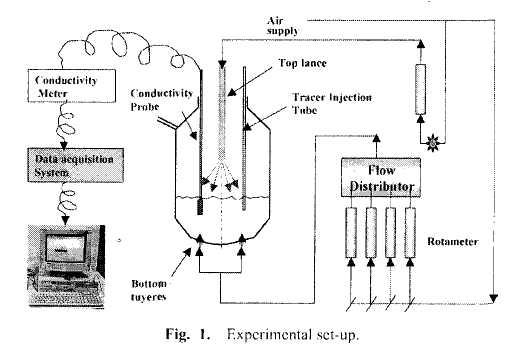Actuality of theme
In combined blown oxygen steelmaking converter, bot¬tom blowing plays important role in mixing within the bath. Better mixing is
believed to cause better homogenisation of the temperature and chemical composition of the bath and improving the reaction rates by bringing reactants
together and moving products away from the reaction site. Bottom blowing plays a major role in the bath mixing and is af¬fected by several parameters like
amount of gas injected, number of tuyeres used, the way tuyere are placed in the bottom i.e. tuyere configuration, shape and size of the bath etc. So there
is a need for optimisation of bottom tuyeres for a given set of parameters to achieve the best possible mixing in the bath. Several investigators1-8 have
studied these parameters to achieve improved mixing in the bath.
Physical Modelling
A model made of plexi-glass was designed and fabricated with 1 :6 scale
and geometrical similarity was maintained as far as possible. Water and
nitrogen were used to simulate the hot metal and argon gas respectively. The
Modified Froude Number was considered to make the model dynamically similar to
the prototype and is defined as the ratio of the inertial force to the buoyancy
force and is calculated as given below:

This modified Froude number1-3,10-13 was used to choose the dimensions
of the top lance tip as well as bottom tuyeres and to estimate the blowing
conditions.

Water
modelling experimentation and mathematical modelling (discrete phase analysis)
in the BOF vessel was carried out to optimise the locations of the bottom
blowing nozzles using mixing time study. The mixing time in the vessel was
found out together with bottom and top blowing as well as by pure bottom
purging by injecting a tracer at a certain location in the vessel and then by
finding the steady state conductivity of the solution. It was found that the
PCR location of 0.4 yields the minimum possible mixing time in the vessel with
combined blowing where as only with bottom blowing the PCR of 0.5 gives the
minimum mixing time as per the experimental observation. PCR in between 0.56 to
0.58 for only bottom blowing showed a very good results.
References
1) A.
Chatterjee, C. Manque and P. Nillcs: Ironmaking Steelmaking, 11 (1984), No. 3,
117.
2) D. Oymo:
Ph. D. Thesis, McGill University, Canada, (1983).
3) R. P.
Singh and D. N. Ghosh: ISIJ Int., 30 (1990), No. II, 955.
4) S. K.
Ajmani and A. Chatterjee: Ironmaking Steelmaking. 23 (1996). No. 4, 335.
5) G.
Akdogan and R. II. Eric: Metall. Mater. Trans. Â. ÇÎÂ (1999). 231.
6) Ñ. Roth. M. Peter, M. Juhart and K. Koch: Steel Res.,
(1999), No. 12,502.
7) O.
Olivarcs, A. Elias, R. Sanchez, M. D. Cruz and R. D. Morales: Steel Res.,
(2002), No. 2, 44.
8) M. J.
Luomala, T. M. J. Fabritius and J. J. Harkki: ISIJ Int., 44 (2004), No. 5, 809.
9) S. Ramai
and A. K. Lahiri: Steel Res., 59 (1988), 193.
10) R. J.
Matway, R. J. Fruhan and H. Hcnin: Iron Steelmaker, 16 (1989). Sept., 51.
11) R. J.
Matway. R. J. Fruhan and II. Hcnin: Iron Steelmaker, 18(1989), Dec, 43.
12) A.
Chattcrjcc, Y. S. Kapadia and J. J. Irani: Proc. of the Steel Eight¬ies Symp.,
cd. by
A. Chatterjee and B. N. Singh, Jamshcdpur, (1980), 23.
13) S. Poul
and D. N. Ghosh: Metall Trans. B, 17B (1986). Sept.. 461.
14) M.
Madan. D. Satish and D. Majumdar: ISIJ Int.. 45 (2005), 677.
15) D.
Majumdar and R. I. L. Guthric: ISIJ Int.. 34 (1994). 384.
16) S. A.
Morsi and A. J. Alexander: J. Fluid Mech.. 55 (1972). 193.
17) B. E.
Launder and D. B. Spalding: Comput. Method Appl. Mech. Eng., 3(1974). 269.
18) C.
Crowe, M. Sommcrfeld and Y. Tsuji:
Multiphase Flows with Droplets and Particles, CRC Press, Boca Raton,
(1998).
19) S. T.
Johanscn and F. B. Boysan: Metall. Trans. Â, 19Â (1987), 755.
20) P. K.
Jha and S. K. Dash: Int. J. Numer. Method Heal Fluid Flow, 12 (2002), No. 5,
560.
21) P. K.
Jha, R. Ranjan, S. S. Mondal and S. K. Dash: «Int. J. Numer. Methods Heal Fluid
Flow»: 13 (2003), No. 8, 964.
Important note
At writing of this abstract of thesis master's degree work is not yet completed. Final completion: December, 2009 Complete text of work and materials and materials on the topic can be got for on author or his leader after the indicated date.



